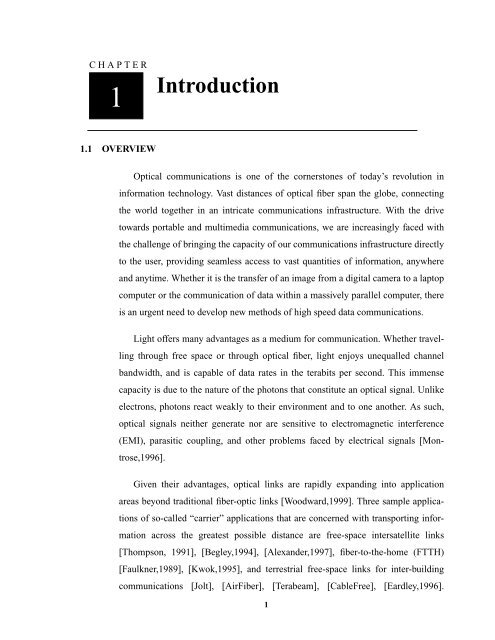CMOS Optical Preamplifier Design Using Graphical Circuit Analysis
CMOS Optical Preamplifier Design Using Graphical Circuit Analysis
CMOS Optical Preamplifier Design Using Graphical Circuit Analysis
You also want an ePaper? Increase the reach of your titles
YUMPU automatically turns print PDFs into web optimized ePapers that Google loves.
CHAPTER<br />
1<br />
1.1 OVERVIEW<br />
Introduction<br />
<strong>Optical</strong> communications is one of the cornerstones of today’s revolution in<br />
information technology. Vast distances of optical fiber span the globe, connecting<br />
the world together in an intricate communications infrastructure. With the drive<br />
towards portable and multimedia communications, we are increasingly faced with<br />
the challenge of bringing the capacity of our communications infrastructure directly<br />
to the user, providing seamless access to vast quantities of information, anywhere<br />
and anytime. Whether it is the transfer of an image from a digital camera to a laptop<br />
computer or the communication of data within a massively parallel computer, there<br />
is an urgent need to develop new methods of high speed data communications.<br />
Light offers many advantages as a medium for communication. Whether travel-<br />
ling through free space or through optical fiber, light enjoys unequalled channel<br />
bandwidth, and is capable of data rates in the terabits per second. This immense<br />
capacity is due to the nature of the photons that constitute an optical signal. Unlike<br />
electrons, photons react weakly to their environment and to one another. As such,<br />
optical signals neither generate nor are sensitive to electromagnetic interference<br />
(EMI), parasitic coupling, and other problems faced by electrical signals [Mon-<br />
trose,1996].<br />
Given their advantages, optical links are rapidly expanding into application<br />
areas beyond traditional fiber-optic links [Woodward,1999]. Three sample applica-<br />
tions of so-called “carrier” applications that are concerned with transporting infor-<br />
mation across the greatest possible distance are free-space intersatellite links<br />
[Thompson, 1991], [Begley,1994], [Alexander,1997], fiber-to-the-home (FTTH)<br />
[Faulkner,1989], [Kwok,1995], and terrestrial free-space links for inter-building<br />
communications [Jolt], [AirFiber], [Terabeam], [CableFree], [Eardley,1996].<br />
1














